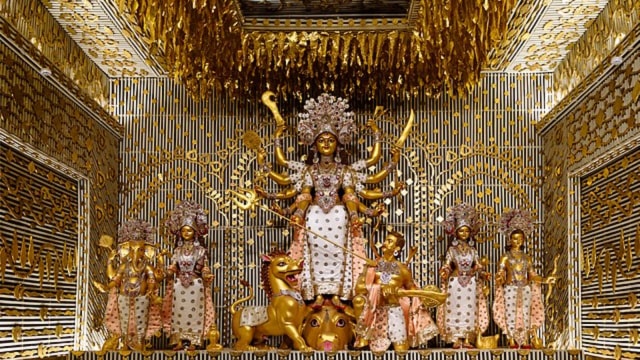
The annual spectacle of Durga Puja in West Bengal, a festival of immense cultural and emotional significance, in recent years seems to have become a potent symbol of a deeper political narrative. While the Trinamool Congress (TMC) government frames its financial grants and incentives to puja clubs as an act of supporting the state’s vibrant cultural economy, this claim glosses over a more complex and troubling reality. The subsidies are not merely about sustaining a festival; they are a strategic political manoeuvre, a calculated response to the BJP’s narrative of “cultural misrecognition” and a consolidation of power through the very clubs that have long held a grip on local life in Bengal.
The incentives provided by the TMC government are indeed generous and multifaceted. In a series of escalating gestures, the government has provided direct financial grants, which have risen from a modest sum in 2018 to a significantly higher amount today. In addition to cash, clubs receive a hefty discount on electricity bills along with a complete waiver of various state government fees, including those for fire licenses and taxes imposed by civic bodies. These are substantial concessions that, on the surface, appear to be a benevolent gesture towards a festival that generates an estimated $4.5 billion creative economy for the state.
However, a closer look reveals that this is less about economics and more about political patronage. The TMC’s grants serve as a direct counter-narrative to the BJP’s persistent accusations of “Muslim appeasement”. By showering money and attention on Durga Puja, the TMC is attempting to demonstrate its embrace of Hindu culture, thereby blunting the BJP’s core electoral plank. It is seemingly a political appropriation of a cultural event.
This cultural politics is intrinsically linked to the role of the puja clubs. These organisations are not just festive committees; they are deeply entrenched power grids within Bengal’s neighbourhoods, or “paras”. For years, they have been the local nodes of political control, often acting with impunity. While they organise the Durga Puja, their influence extends far beyond the festive season. They are often the conduits for control over local populations. Allegations of extortion are rampant, particularly in the lucrative real estate sector. These clubs, with their political patrons, are accused of extorting “donations” from land sales and new construction projects, effectively functioning as a parallel, unofficial tax collection system.
Moreover, these clubs often operate as de facto moral police in their communities. They can exert social pressure, settle local disputes, and even enforce their own brand of justice. This is not a new phenomenon, but the TMC’s financial and political endorsement of these clubs seems to have further legitimised their extralegal authority. By funnelling public funds through these organisations, the ruling TMC effectively turns them into an extension of its political machinery. The grants are a form of political capital, ensuring the loyalty of these local power brokers who can mobilise support, intimidate opponents, and ensure electoral victories at the grassroots level.
The argument that these grants are essential for the economic sustenance of the puja industry also falls apart under scrutiny. While the festival is undoubtedly a major economic driver, the bulk of the economic value is generated by consumer spending, advertising, and corporate sponsorships. The government grant, while not insignificant for smaller clubs, is a small fraction of the total expenditure for many of the larger and more popular pujas. The real significance of the grant is not its economic necessity but its political utility. It provides the TMC with a direct and public way to co-opt a powerful and influential network of local actors.
The entire arrangement, therefore, can be viewed as a classic example of what political scientists refer to as “patronage politics.” The state, under the guise of cultural promotion, distributes largesse to a network of loyalists who, in turn, ensure political compliance and control. Further, the clubs are rarely subjected to rigorous audits, and there is little transparency about how these public funds are utilised.
The TMC’s financial support for Durga Puja clubs in West Bengal is far more than a simple act of cultural patronage. It is a politically astute strategy designed to achieve multiple objectives: To counter the BJP’s cultural offensive, to consolidate power at the local level through a network of influential clubs, and to create a public perception of inclusivity. The vibrant cultural celebration of Durga Puja has, in this process, become a casualty, its sanctity and essence overshadowed by the politics of cultural (mis)recognition and the transactional nature of power.
The writer is a political anthropologist, and teaches at Government General Degree College, Keshiary, Paschim Medinipur, West Bengal